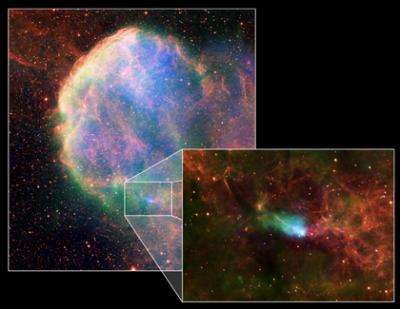Credit: Chandra X-ray: NASA/CXC/B.Gaensler et al; ROSAT X-ray: NASA/ROSAT/Asaoka & Aschenbach; Radio Wide: NRC/DRAO/D.Leahy; Radio Detail: NRAO/VLA; Optical: DSS
A long observation with NASA's Chandra X-ray Observatory revealed important new details of a neutron star that is spewing out a wake of high-energy particles as it races through space. The deduced location of the neutron star on the edge of a supernova remnant, and the peculiar orientation of the neutron star wake, pose mysteries that remain unresolved.
"Like a kite flying in the wind, the behavior of this neutron star and its wake tell us what sort of gas it must be plowing through," said Bryan Gaensler of the Harvard-Smithsonian Center for Astrophysics in Cambridge, Mass., and lead author of a paper submitted to The Astrophysical Journal. "Yet we're still not sure how the neutron star got to its present location."
The neutron star, known as CXOU J061705.3+222127, or J0617 for short, appears to lie near the outer edge of an expanding bubble of hot gas associated with the supernova remnant IC 443. Presumably, J0617 was created at the time of the supernova -- approximately 30,000 years ago -- and propelled away from the site of the explosion at about 500,000 miles per hour.
However, the neutron star's wake is oriented almost perpendicularly to the direction expected if the neutron star were moving away from the center of the supernova remnant. This apparent misalignment had previously raised doubts about the association of the speeding neutron star with the supernova remnant.
Gaensler and his colleagues provide strong evidence that J0617 was indeed born in the same explosion that created the supernova remnant. First, the shape of the neutron star's wake indicates it is moving at the predicted pace, which is a little faster than the speed of sound in the remnant's multimillion-degree gas. In contrast, if the neutron star were outside the confines of the remnant, its inferred speed would be a sluggish 20,000 miles per hour. Also, the measured temperature of the neutron star matches that of one born at the same time of the supernova remnant.
What then, could cause the misaligned, or wayward, neutron star wake?
The authors speculate that perhaps the doomed progenitor star was moving at a high speed before it exploded, so that the explosion site was not at the observed center of the supernova remnant. Fast moving gusts of gas inside the supernova remnant have further pushed the neutron star's wake out of alignment.
Observations of J0617 in the next 10 years should put this idea to the test. "If the neutron star was born off-center and if the wake is being pushed around by cross-winds, the neutron star should be moving close to vertically, away from the center of the supernova remnant. Now we wait and see," said Gaensler.
Another group, led by Margarita Karovska, also of the Harvard-Smithsonian Center, has concentrated on other, previously unnoticed intriguing features of J0617. At a recent conference on neutron stars in London, England, they announced their findings, which include a thin filament of cooler gas that appears to extend from the neutron star along the long axis of its wake, and a second point-like feature embedded in the X-ray nebula around the neutron star
"There are a number of puzzling observational features associated with this system crying out for longer observations" said Karovska.
Source: Chandra X-ray Center
























